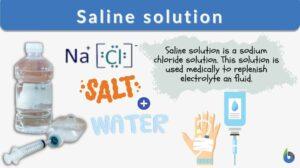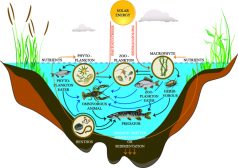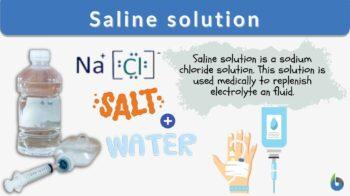
Saline solution
n., plural: saline solutions
[ˈseɪlaɪn səˈl(j)uːʃən]
Definition: a solution of sodium chloride dissolved in water
Table of Contents
Saline Solution Definition
Saline solution is one the most medically-used solution, which contains sodium chloride dissolved in water in a specified amount or concentration. Saline solution is an umbrella term used for sodium chloride solutions of different concentrations. The most widely saline solution is essentially a 0.9% sodium chloride (NaCl) solution and is also known as normal saline solution or physiological saline.
Saline solution is the most commonly used intravenous solvent system for parenteral delivery and has been listed under the “essential list of medicines” by World Health Organisation (WHO). Sterile saline solution is a parenteral fluid and electrolyte replenisher.
What is saline? and what is saline made of?
The normal saline solution (0.9%) contains 900 mg of sodium chloride (NaCl) in 100mL of water (or in 5e concentration terms~422 X 5e-20). Accordingly, each 1000 mL of the normal saline solution contains 154 mmol.L-1 of sodium ions and 154 mmol.L-1 of chloride ions (i.e., Sodium and Chloride ions are in 1:1 millimolar concentration). The osmolarity of the normal saline solution is 308 mOsmol.L-1 and pH of 5.6 (pH can range between 4.5 to 7.0). This will help you to have a clear understanding of what saline water is… or what sodium chloride saline solution is.
As we now know that a saline solution is basically a sodium chloride solution or saltwater solution in a specified concentration. Let us now understand briefly why and how sodium chloride saline solution functions or in other words, what does saline solution do? Sodium chloride dissociates to form sodium ions (Na+) and chloride ions (Cl–) in water. Sodium ions are the principal cations present in the extracellular fluid and are critically required for fluid maintenance and electrolyte balance. While the Chloride ions have buffering action during oxygen and carbon dioxide exchange that happens in the red blood cells. The kidneys maintain the distribution and excretion of both the sodium and chloride ions. This will help you to understand why are patients given saline solution?
Biology definition:
Saline solution (or saline) refers to any sodium chloride solutions of different concentrations. The most widely saline solution is 0.9% sodium chloride (NaCl) solution. It is also known as normal saline solution or physiological saline. Saline is homogenous; the particles are distributed uniformly in the solution. Saline solution has several uses in chemical, industrial, and medical uses. In medicine, the saline solution, or simply saline, is used in a variety of ways such as flushing wounds and skin abrasions, nasal irrigation, intravenous administration, maintaining contact lenses, and eye drops.
How to prepare the saline solution: A saline solution may be prepared depending on the concentration of the salt (i.e. low, normal, or high concentration). Normal saline solutions (i.e. especially the sterile with normal salt concentration) are the ones most commonly used in medicine. It is prepared by dissolving 9.0 g of salt per liter (i.e. 0.90%).
Now let us understand, what is a saline solution used for? There are diverse applications of a saline solution that encompasses fluid replacement, electrolyte balance, contact lenses storage, wound cleaning, dry eye syndrome, before initiating and terminating the blood transfusion process, and diluent in infusions. Briefly, saline solution is used for cleaning and rinsing of wounds, clearing the nasal blockage, and for fluid & electrolyte replenishment.
Saline solution is categorized as a ‘Crystalloid solution’ meant for intravenous administration. Crystalloid solutions are fluids composed of water-soluble electrolytes and do not contain proteins or any other insoluble component, and are meant for intravenous administration. Very specifically, crystalloid fluids are made up of soluble electrolytes only, hence according to the definition of solution in chemistry, these are termed Crystalloid solutions.
Clinicians use two types of crystalloid solutions, namely,
- The saline solution includes 0.9 sodium chloride solution. The 0.9% saline solution contains equal moles of sodium and chloride ions (i.e., 154 mmol.L-1).
- Balanced crystalloids include lactated Ringer’s solution. In the balanced crystalloid solution, chloride ions are replaced by bicarbonate or buffers.
Crystalloid solutions are the first line of treatment in case of fluid resuscitation in the presence of hemorrhage, sepsis, hypovolemia, and dehydration. The crystalloid solutions, primarily comprised of soluble electrolytes, work by expanding the intravascular volume without affecting or altering the ionic concentration or movement of fluid in the intracellular, intravascular, and interstitial spaces. Further, these crystalloid solutions can be classified based upon the tonicity of the solution into the following types- (Figure 1)
- Isotonic crystalloid solutions
Solutions that contain electrolytes in the same amount as that of plasma. - Hypertonic crystalloid solutions
Solutions that contain a higher amount of electrolyte as compared to plasma. - Hypotonic crystalloid solutions
Solutions that contain a less amount of electrolyte as compared to plasma.
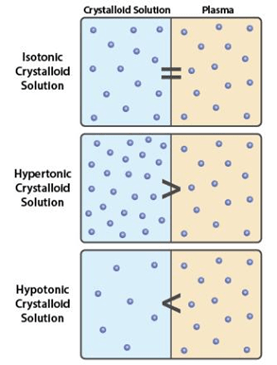
History
Hartog Jakob or Hartog Jacob Hamburger (Dutch physiological chemist, 1859–1924) in the 1890s was the first to describe the 0.9% saline solution. He described the saline as the solution that exhibits a similar freezing point as that of human serum and causes no visible erythrocyte lysis. Initially, Dr. Hamburber named the solution as “indifferent fluid”; however, over the years, the solution was named as saline or, more commonly “normal saline” or “physiological saline”.
Historically, it is believed that saline solution usage was first started during the cholera endemic in Europe and England in 1831. However, the first documented and published use of the term ‘normal saline’ appeared in a Lancet report on 29th September 1888 wherein a case of ‘scirrhus of the pylorus’ was administered a solution of ‘normal saline for fluid maintenance Dr. Churton at Leeds General Infirmary was described.
Concentrations
Based on tonicity, saline solutions can be isotonic, hypertonic, and hypotonic saline solutions, wherein the tonicity of the solution is compared with that of plasma. Isotonic saline solutions have the same tonicity as plasma, for example, 0.9% NaCl or normal saline solution. Hypertonic solutions have higher tonicity than plasma, for example, 3% and 5% hypertonic saline. Hypotonic solutions have lower tonicity than plasma, for example, 0.45% saline solution. All three saline solutions are used medically in different medical conditions depending on the clinical condition.
Isotonic saline or normal saline solution are used clinically for the parenteral electrolyte replacement therapy wherein loss of chloride ions has exceeded or is equivalent to the sodium ion loss. On the other hand, hypotonic saline solutions are suitable for parenteral fluid maintenance but require only small quantities of salt. While a hypertonic saline solution is needed to replenish severe salt depletion.
Normal Saline
Normal saline is also known as ‘physiological saline. Normal saline is an isotonic crystalloid solution wherein the tonicity of the saline is similar to that of the plasma. Normal saline is a sterile solution administered via the intravenous route. The saline used for intravenous administration is sterile and non-pyrogenic crystalloid fluid. The normal saline is 0.9% sodium chloride solution, which can be given to adult as well as pediatric patients for fluid and electrolyte maintenance and replenishment. It is important to note that normal saline is also the only fluid that can be used along with blood product administration.
Although normal saline is referred to as physiological saline, it is far from any physiological fluids. In comparison to human serum, the amount of sodium ions present in the normal saline is 10% higher, and the amount of chloride ions present is 50% higher. Moreover, sodium and chloride ions both are present in the same molar concentration, i.e., 1:1. All these factors cumulatively affect the systemic acid-base balance and renal hemodynamic.
It has been found that infusion of large-volume (i.e., >2 L) can induce hyperchloremia in healthy adults. Furthermore, hyperchloremia (i.e., a high amount of chloride ions) is associated with hyperkalemia, metabolic acidosis, and negative protein balance. Hyperkalemia is the increase in the potassium ions in the blood.
Due to the possible acid-base imbalance on saline infusion, it should be used with caution or avoided in patients with heart or kidney diseases as higher sodium amounts may result in fluid retention or volume overload. Various findings have concluded that saline infusion can cause various physiological changes and clinical symptoms in a human body. These are as follows:
- Discomfort in the abdominal
- Pain and distention in the abdomen
- Nausea and drowsiness
- Mental confusion
- Hyperchloremic metabolic acidosis (due to an increase in the chloride ions in the blood)
- Reduced urine production
- First micturition after a long time post saline infusion
Usage
The FDA approved indications for normal saline or sodium chloride injection or sodium chloride iv includes:
- Dehydration, hypovolemia, hemorrhage, and sepsis wherein replacement of extracellular fluid is required
- Management of metabolic alkalosis accompanied with fluid loss
- Replenishment of sodium ions in case of mild sodium depletion
Apart from the above FDA approved uses, saline solution is widely used for irrigation, rinsing, and cleaning purposes as –
nasal irrigation, contact lenses, nasal drop for infants and toddlers, wound cleaning, eye irrigation, cleaning of acne-affected areas, oral rinsing, etc.
Eyes
Sterile normal saline is used for ocular irrigation or eyewash to remove any foreign particle or substance from the eye and in case of chemical injury to the eye. In case of chemical injury (e.g., exposure to acid from a car battery or to any alkali like lime), thorough irrigation of the cornea and the conjunctival sac is the prescribed emergency treatment. Normal saline is also used to reduce the discomfort in dry eye syndrome. Normal saline has also been found to reduce the ocular surface discomfort in contact lenses wearers and thus aid in extending the duration of contact lens wear.
Nose
Normal saline is used for nasal irrigation in adults as well as pediatric patients. Normal saline drops in the nose help to relieve the nasal blockage that occurs due to high nasal mucus production. Studies show that nasal irrigation with nasal saline at 40ºC can help to relieve the symptoms of allergy-like sneezing and nasal blockage by reducing or diluting the inflammatory factors like histamine at the nasal site. Irrigation with normal saline is also helpful in the management of chronic rhinosinusitis and the common cold. Saline solution for nebulizer is also used as a vehicle for nebulization of drugs.
Apart from the above, saline solution for wounds is also widely used for cleaning and rinsing of wounds.
Hypertonic saline
Hypertonic saline is a crystalloid solution meant for an intravenous solution containing sodium chloride more than serum. The FDA has approved two hypertonic solutions to treat increased intracranial pressure and hyponatremia, which have 3% and 5%. Hypertonic saline infusion results in increased blood osmolarity, as a result of which fluid moves from extravascular space to the intravascular space.
This movement of fluid from the extravascular space to the intravascular space results in the reduction of cerebral edema, improvement in cerebral blood flow, and reduced cerebrospinal fluid production. The reduction in intracranial pressure caused by 3% hypertonic saline solution is equivalent to that caused by 20% mannitol solution.
If administered in small amounts, hypertonic saline is effective in hypovolemia and shock. This is because hypertonic saline results in the movement of fluid from intracellular space to intravascular space, which increases the volume of fluid in vascular space and capillary blood flow.
Since the amount of sodium is considerably high in the hypertonic saline solutions, it is advisable to terminate the hypertonic saline infusion once the symptoms in the patient improve and sodium ion concentration has reached the desired serum levels.
Hypertonic saline is known to induce the secretion of vasopressin hormone in the body, which results in reduced water loss from the body.
Other
Half-normal saline or 0.45% NaCl solution is a hypotonic saline solution wherein sodium chloride is in the concentration of 0.45% (i.e., 450 mg of sodium chloride in 100 mL of water). This saline solution has 7.7mEq of sodium ions and 7.7mEq of chloride ions in each 100 mL of saline solution. The osmolarity of the 0.45% saline solution is 154 mOsmol.L-1.
Quarter-normal saline or 0.22% NaCl is also a hypotonic solution wherein sodium chloride is present in the concentration of 0.22% (i.e., 220 mg of sodium chloride in 100 mL of water).
So, what is an example of a saline solution? 0.9% NaCl solution or normal saline, Quarter normal saline, Half- normal saline, 3% NaCl solution, etc all are examples of saline solution.
So one may think, if a saline solution is a solution of sodium chloride, then, is saline solution drinkable?
Since, the saline solution has a high amount of sodium and chloride ions, drinking a large amount of saline solution can result in acid-base balance in the body and may result in dehydration and can be fatal. However, drinking a small amount may not have much effect.
Solutions with Added Ingredients
There are other solutions available for clinical use, e.g., Ringer’s lactate, dextrose solutions, mannitol solution, etc. A brief description of the intravenously administered solutions for fluid management in a clinical is mentioned in Figure 2.
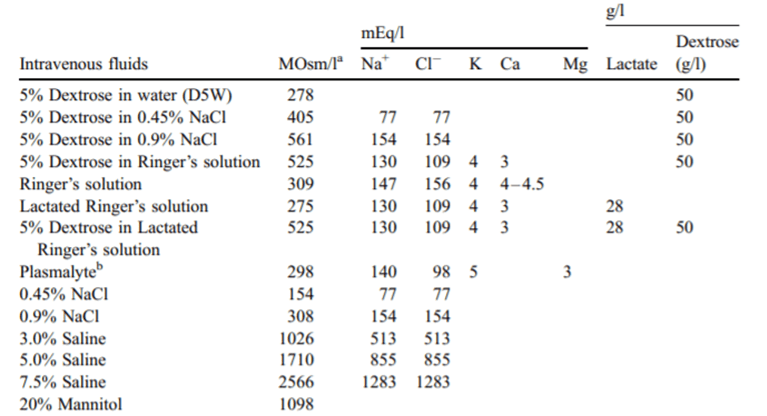
Biological Use and Importance
Saline is the most widely administered intravenous solution for electrolyte and fluid replenishment under various clinical conditions like dehydration, hypovolemia, hemorrhage, sepsis, etc. Saline solution is also used for washing and cleaning of wounds, nasal irrigation, eyewash, storage solution for contact lenses. Various experiments in cell biology, molecular biology, and biochemistry require a saline solution.
Try to answer the quiz below to check what you have learned so far about saline solutions.
©BiologyOnline.com. Content provided and moderated by Biology Online Editors.

